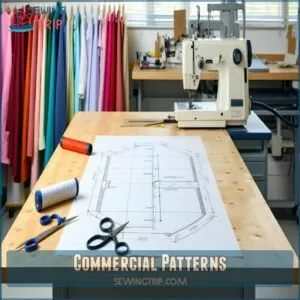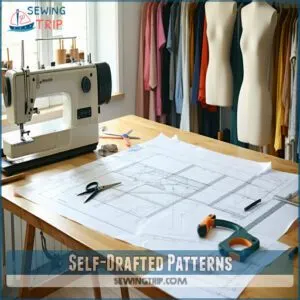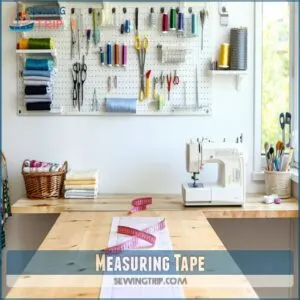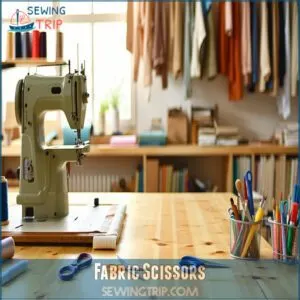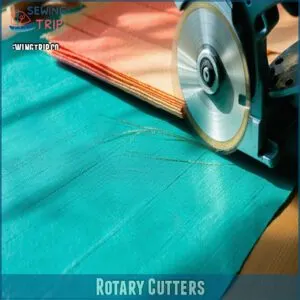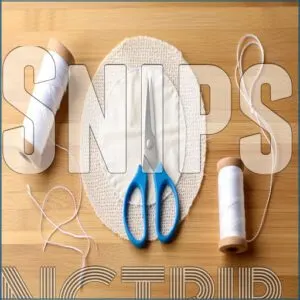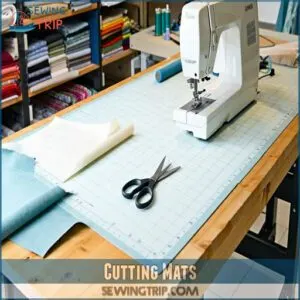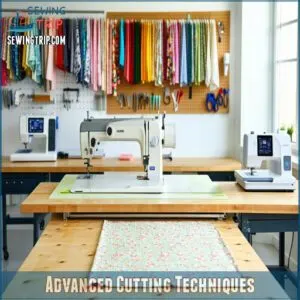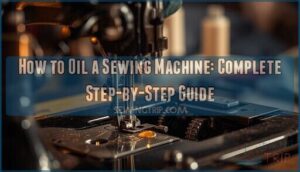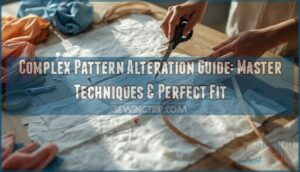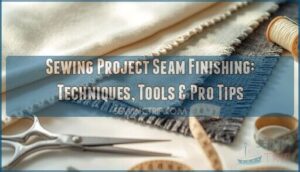This site is supported by our readers. We may earn a commission, at no cost to you, if you purchase through links.
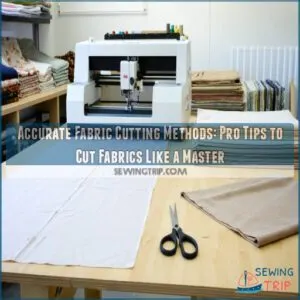 To master accurate fabric cutting methods, start by prepping your fabric—smooth out wrinkles with a steam iron and align the grain with the pattern for precision.
To master accurate fabric cutting methods, start by prepping your fabric—smooth out wrinkles with a steam iron and align the grain with the pattern for precision.
Use sharp fabric scissors or a rotary cutter for clean, fray-free edges. Weights or pins are your best friends for holding fabric in place on a large, flat cutting surface.
Got a tricky fabric? Test small cuts first to avoid surprises. For advanced accuracy, explore tools like laser cutters or CNC machines, especially for intricate patterns.
Whether you’re aiming for bias cuts or fussy motifs, choosing the right method shapes your project’s success.
Table Of Contents
Key Takeaways
- Smooth out wrinkles with a steam iron and align the fabric grain to ensure precise cuts and prevent distortion.
- Use sharp tools like fabric scissors or rotary cutters on a flat surface with weights or pins to keep the fabric steady.
- Match the cutting method to your project; scissors work best for curves, rotary cutters for straight lines, and automated tools for intricate designs.
- Always test tricky fabrics, consider stretch and drape, and double-check grain alignment to avoid cutting mistakes.
Fabric Cutting Basics
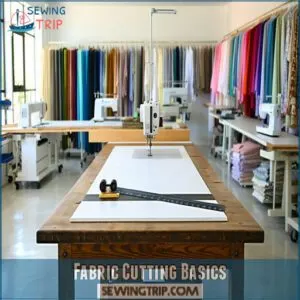
Cutting fabric accurately starts with using the right tools and preparing your workspace properly. Smooth out wrinkles, press the fabric, and align it carefully to set yourself up for success.
Essential Tools and Supplies
To master precise fabric cutting, start with the right tools.
A large, flat cutting surface guarantees accuracy.
Fabric shears and rotary cutters provide precision, while fabric markers help guide cuts cleanly.
Don’t skip sewing notions like rulers, measuring wheels, or cutting guides—they’re essential for consistency.
Pair this with an ironing board for wrinkle-free fabrics, and you’re unstoppable!
Investing in quality fabric cutting tools can substantially improve your overall sewing experience.
Laying Out Fabric
Precision starts with proper fabric layout.
Align the fabric grain with the grainline on your pattern for cutting precision.
Use a flat, firm cutting surface for stability and better accuracy.
Follow these steps:
- Match selvedges to confirm fabric grain alignment.
- Smooth fabric and remove wrinkles for stabilization.
- Place weights to prevent shifting during fabric cutting.
Smoothing Out Wrinkles
Before you begin cutting, fabric wrinkles need taming.
A self-healing cutting mat won’t help here, but your iron will.
Focus on smoothing techniques like light steam application or spritzing water from a mist bottle.
Gently glide the iron—don’t stretch the fabric.
These steaming methods relax the fabric, ensuring accuracy.
Fabric relaxation makes patterns align and cuts precise, which is crucial for the overall quality of the work, involving smoothing techniques.
Pressing Fabric With Steam
Pressing fabric with steam sets the stage for perfect cuts.
Use a steam iron for wrinkle removal and fabric relaxation.
Follow these steps for fabric smoothing and cutting accuracy:
- Spritz tough creases with a water mist bottle.
- Glide the iron gently, ensuring even steaming techniques.
- Let the fabric cool completely to avoid unwanted shrinkage.
Understanding proper pressing techniques is essential for achieving professional results in fabric cutting and sewing projects.
Choosing Cutting Methods
Choosing the right cutting method is the first step to ensuring precision and ease in your project.
Whether you’re using commercial patterns, self-drafted designs, or body measurements, it’s all about matching the method to your fabric and goals.
Commercial Patterns
Using commercial patterns streamlines fabric cutting accuracy by giving you pre-designed templates for precise fabric cuts.
Align the straight grain with the pattern’s grainline for fabric cutting precision. Pin the pattern firmly to avoid shifting—trust those sewing notions!
Double-check fabric layout to prevent cutting errors, ensuring garment fitting stays on point. Accurate pattern cutting means happier, better-fitting clothes, which is the result of following these steps carefully for precise fabric cuts.
Self-Drafted Patterns
Creating self-drafted patterns reveals custom fits and unique designs.
Your drafting skills are key to accurate fabric cutting.
Here’s how to start:
- Sketch your design and convert it into precise measurements.
- Transfer details onto pattern paper, providing straight lines for fabric cutting precision.
- Double-check seams and adjustments for personalized sewing success.
Understanding and applying proper pattern making techniques can substantially enhance your sewing skills.
Mastering this guarantees accurate pattern cutting every time, which leads to personalized sewing success.
Body Measurements
Skip guessing your size; knowing your body proportions leads to accurate fabric cutting.
Use precise measurement tools to record your bust, waist, hips, and more.
These fabric cutting measurements guarantee garment fitting shines.
Pair your measurements with sizing charts for proper fit analysis.
Remember, body proportions and fabric grain alignment are everything for mastering cuts made to fit you.
Measuring Tape
Grab a measuring tape—it’s your best friend for measurement precision! Whether marking directly on fabric with fabric markers or using flexible rulers for curves, measuring tape guarantees fabric cutting measurements stay accurate.
It prevents cutting errors that ruin projects. For accurate cutting methods, double-check tape alignment and always measure twice.
Precise measurement tools make all the difference in fabric cutting.
Fabric Properties Matter
Understanding your fabric’s stretch, drape, and grain is key to cutting accurately and avoiding mistakes.
Each fabric behaves differently, so paying attention to its unique properties will save time and frustration.
Fabric Stretch and Drape
Stretch factors and drape control can make or break your project.
Knit fabrics often stretch unpredictably, causing fabric distortion if mishandled.
Always evaluate fabric elasticity and drape behavior before cutting.
Test the textile’s properties by pulling it gently and observing its fall.
Misjudged fabric drape leads to wasted material—precision here guarantees fewer mistakes and more efficient fabric use, ensuring better fabric use.
Fabric Grain Influence
If you cut fabric without considering grain direction, you’ll risk fabric distortion and cutting errors that ruin your project.
The grainline matters! Always align pattern pieces with warp threads (running parallel to the selvage) and check weft alignment for accuracy.
Follow these steps:
- Flatten fabric, ensuring selvage edges match.
- Mark the grainline on patterns.
- Avoid off-grain cuts completely.
Fabric Finishes and Coatings
Fabric finishes and coatings change how textiles behave.
A glossy coating might add water resistance, while others enhance durability or texture.
Fabric treatments can stiffen or soften textile surfaces, impacting cutting ease.
Always check finish effects to avoid fabric distortion or waste.
Test cuts help maintain accuracy, especially when dealing with multiple fabric layers or tricky material enhancers.
| Coating Type | Purpose | Pros | Considerations |
|---|---|---|---|
| Water-Resistant | Protects from spills | Adds functionality | May stiffen fabric |
| Glossy Finish | Adds shine | Enhances appearance | Can affect drape |
| Durable Coating | Improves lifespan | Withstands wear | Tougher to cut |
| Softener | Adds flexibility | Easier to manipulate | Reduces structure |
Straight Grain Importance
Proper grain alignment is key to avoiding fabric distortion and ensuring cutting accuracy.
The fabric grain, especially the straight grain or grainline, directly affects seam stability and the textile structure.
Misaligned cuts lead to twisted garments and uneven seams.
- Double-check grainline placement for straight cuts.
- Align selvedges carefully before pinning patterns.
- Use weights or pins to keep fabric properties stable while cutting.
Cutting Tools and Techniques
Using the right cutting tools guarantees clean, precise edges and saves you time.
From sharp fabric scissors to versatile rotary cutters, each tool has a specific role in creating accurate cuts for your projects, which involves using the right cutting tools.
Fabric Scissors
Choosing accurate fabric scissors is key to precise cutting techniques.
Keep them sharp for smooth Fabric Handling—Scissor Maintenance is your best friend!
Always go for blade sharpening instead of replacement.
Bonus tip: ergonomic handles save your wrists during long projects.
Need clarity? Here’s a quick guide: When selecting the right tools, consider visiting a website for fabric scissors information.
| Feature | Benefit |
|---|---|
| Bent Handles | Smooth, accurate cuts |
| Stainless Steel | Long-lasting durability |
| Micro-serrated Edge | Ideal for slippery fabric |
| Comfortable Grip | Better Cutting Ergonomics |
| Adjustable Screw | Personalized blade tension |
Rotary Cutters
While fabric shears handle curves well, a rotary cutter is your go-to for clean, straight lines.
Its rotary blades glide effortlessly, cutting through multiple layers with ease.
Keep blade sharpening in mind for consistent rotary cutter precision.
Remember, cutting safety matters—steady hands and proper technique guarantee control.
For durability, follow cutter maintenance tips to keep this precise fabric cutting tool ready.
Using the right Rotary Cutter Tools can substantially improve the accuracy of your fabric cuts.
Pinking Shears
Tired of fraying edges ruining your hard work? Pinking shears are your go-to for Seam Finishing and Fraying Prevention.
These sharp scissors create Zigzag Edges that reduce Fabric Distortion while enhancing Cutting Precision.
Here’s why they’re some of the most Accurate Fabric Cutting Tools:
- Great for delicate seams.
- Help fabrics stay intact.
- Work well post-cut.
- Easy to use!
Snips
For those intricate tasks like thread cutting, fabric notching, or seam preparation, snips are your go-to.
These small yet mighty tools allow for precise trimming and handle tight spots regular scissors can’t manage.
Whether you’re tackling minor adjustments or aiming for accurate fabric shears-level precision, snips are essential for cutting fabric accurately in detailed sewing projects.
Using the right thread snipping tools can substantially improve the quality of your sewing outcomes by enabling clean cuts and preventing loose threads.
Cutting Mats
Snips handle small cuts, but for bigger jobs, cutting mats are your steady sidekick.
A self-healing cutting mat protects your surfaces and keeps cuts smooth.
Look for:
- Durable materials that resist wear.
- Gridlines for precise cuts.
- Easy maintenance—wipe it clean often!
Place fabric flat, stabilize it, and trust your mat for clean, accurate results.
Advanced Cutting Techniques
When it’s time to tackle more complex projects, advanced cutting techniques help you work with precision and creativity.
From bias cutting to laser-guided methods, these approaches guarantee flawless cuts for even the most detailed designs.
Bias Cutting
When you’re tackling tricky curves or aiming for a sleek, fluid fit, bias cutting is your go-to.
By slicing fabric at a 45-degree angle to the grain, you reveal amazing fabric draping and flexibility.
Whether crafting bias strips for trims or enhancing a garment’s flow, trust accurate fabric cutting tools to prevent fabric distortion and keep those cutting angles sharp.
Fussy Cutting
Got a fabric with bold designs? Fussy cutting helps you highlight standout motifs by carefully planning the pattern placement.
Use accurate fabric cutting tools like scissors or rotary cutters for cutting precision.
Fabric cutting templates can guide you in motif matching while respecting texture control.
This method transforms fabric selection into art, ensuring designs pop right where they should, which is the goal of fussy cutting and requires accurate fabric cutting tools.
Layer Cutting
When fussy cutting’s precision feels satisfying, layer cutting steps up for speed.
Lay multiple fabrics flat, stack evenly, and secure with weights for high-quality Fabric Stacking and Cutting Alignment.
A rotary cutter paired with sharp blades shines here, ensuring Fabric Cutting Accuracy across layers.
Handle Multi Layer setups carefully—it saves time without compromising your fabric cutting methods or Precision Cutting results.
Automated Cutting Methods
Automated cutting methods revolutionize how you handle fabric.
These systems combine speed, precision, and innovation—saving you time and effort.
Here’s what makes them game-changing:
- CNC Fabric Cutting Machines: High accuracy with machine learning for complex patterns.
- Laser-Guided Tools: Perfect cuts with minimal waste.
- Automated Spreaders: Smooth alignment for wrinkle-free cutting.
- Robotic Assistants: Boost cutting efficiency across projects.
Additionally, utilizing water jet cutters can substantially enhance the fabric cutting process with their high-pressure technology.
Laser Cutting
When automating fabric cutting, laser cutters bring unmatched precision.
These laserguided tools guarantee clean edges with no fraying, thanks to non-contact cutting.
By adjusting beam focus and cutting speed, you control every detail, while material selection determines the results.
Laser cutting fabric works for almost anything, from silk to synthetic blends—making CNC fabric cutting machines a designer’s dream for efficiency.
For more information on laser cutting fabric techniques and capabilities, understanding the machine’s specifications is vital.
Water Jet Cutting
Water jet cutting uses high water pressure and jet streams to slice through fabrics with stunning precision.
Controlled by a computer, it delivers fabric cutting accuracy without heat damage.
The nozzle design guarantees smooth edges, perfect for delicate textiles.
While it’s a game-changer for thin materials, cutting speed decreases with thicker layers, making precision cutting tricky, which affects work on thicker layers.
Ultrasonic Cutting
If water jet cutting’s gentle touch impressed you, ultrasonic cutting might feel like magic.
Sonic waves slice fabrics with ease, sealing edges to halt fraying.
Ideal for synthetic or non-woven materials, it’s energy-efficient and safer than lasers.
For quilters seeking enhanced speed and precision, exploring fabric cutting machines offers a transformative approach.
- Delivers Ultrasonic Edge precision
- Combines cutting and Fabric Sealing
- Perfect for heat-sensitive fabrics
- Boosts fabric cutting accuracy effortlessly
Computer-Controlled Knife Cutting
While ultrasonic cutting seals with sound, computer-controlled knife cutting uses CNC machines for precision cutting.
Automated systems and CAD software guide knives to slice curves, angles, and straight lines with unmatched accuracy.
| Advantages | Disadvantages |
|---|---|
| Minimal cutting defects | High initial cost |
| Handles multiple materials | Requires skilled operator |
| Rotates in all directions | Maintenance is pricey |
| Compressed fabric stability | |
| Speed control flexibility |
Frequently Asked Questions (FAQs)
How to cut fabric effectively?
Sharp tools make all the difference.
Smooth out the fabric, match selvedges, and double-check pattern placement.
Use steady hands, a flat surface, and consistent pressure to avoid mistakes, ensuring precision every step of the way.
How do you accurately cut woven fabrics?
Line up the selvedge edges, smooth wrinkles, and make certain the grain runs straight.
Pin your pattern securely, use sharp scissors or a rotary cutter, and take long, steady cuts to avoid jagged edges or distortion.
What tools do you need to cut a fabric?
You’ll need sharp fabric scissors or a rotary cutter, a cutting mat for precision, and measuring tools like a ruler or tape measure.
Add pattern weights or pins to keep everything steady while you cut.
How do you cut fabric straight?
Imagine lining up fabric, only to end with a crooked piece—it’s frustrating, right?
Smooth it flat, align the selvedges, use a cutting mat’s grid, and cut slowly with sharp scissors or a rotary cutter.
How do you cut a fabric for a sewing machine?
Lay your fabric flat, make certain it’s wrinkle-free, and align the grain parallel to the selvedge.
Pin your pattern, mark with chalk or pencil, then cut precisely with sharp scissors or a rotary cutter for accuracy.
How do I choose a fabric cutting method?
Picking a cutting method is like finding the right key for a lock—match it to your fabric’s weight, stretch, and project needs.
Rotary cutters excel for straight lines, while scissors handle curves best, which can be considered a cutting method.
What is the most precise way to cut fabric?
The most precise way to cut fabric is by using a rotary cutter on a self-healing mat.
This method involves aligning your pattern carefully with the grain, and securing everything with weights to prevent any slipping or shifting.
Which fabric cutting method is best?
The best fabric cutting method depends on your project and fabric type.
Rotary cutters are great for precision on straight lines, while scissors excel at curves.
For intricate patterns or bulk cutting, automated cutters shine.
What is the best way to cut fabric evenly?
Think of cutting fabric like slicing a perfect cake—steady hands make all the difference.
Line up your fabric on a cutting mat, match the grain, smooth wrinkles, and use sharp scissors or a rotary cutter.
How to cut the fabric correctly?
Line up your fabric’s selvedges, lay it flat on a cutting mat, and smooth out wrinkles.
Use sharp scissors or a rotary cutter, follow grain lines, and double-check your measurements before making any cuts.
Conclusion
Who knew cutting fabric could feel like precision engineering? But with these accurate fabric cutting methods, you’re set to create flawless pieces every time.
From mastering tools like rotary cutters to understanding fabric grain and stretch, your projects will benefit from each careful step.
Don’t skip the basics—smooth your fabric, align patterns, and trust the right tools, which are essential for achieving professional results with techniques such as bias cuts.
Whether it’s bias cuts or advanced laser techniques, accurate cutting is your secret weapon for professional results.
- https://www.spencerogg.com/a-beginners-guide-to-accurately-cutting-fabrics/
- https://textilementor.com/fabric-cutting-methods-essential-guide-beginners/
- https://sarahgoerquilts.com/2017/07/14/my-favorite-tips-and-tools-for-accurate-fabric-cutting/
- https://blog.treasurie.com/how-to-cut-fabric/
- https://www.techniwaterjet.com/fabric-textile-cutting/

